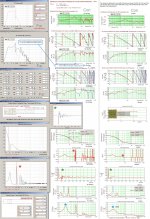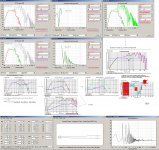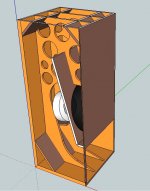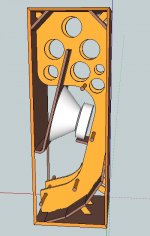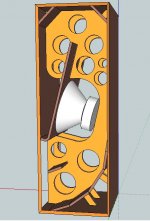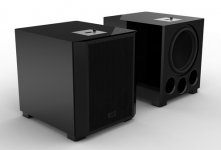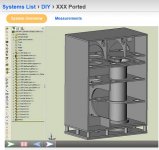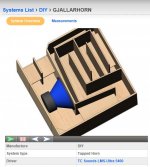I was actually thinking fatter and lower, not as tall as the one shown, which should give a good sized mouth.
I had a quick measure of one of my current OB baffles last night with the tweeter, mids, mid woofers and it is roughly a 600mm x 1200mm sheet (24” x 48”)
I could live with the sub being 600mm deep (24”), I also think I could live with it being a bit taller, but not too much say 1500 (60”)
So that would make for a cabinet 600mm (24”) wide, 600mm (24”) deep, by 1500mm (60”) high or 540 litres (20 cu ft).
Figuring it wouldn’t need to be tuned crazy low, I wonder if it might be enough… the GJALLARHORN is 28.13 cu ft, and tuned for 17Hz
If I aim for 20.5Hz like sylk suggested for optimal efficiency, I would have to be in the ball park.
I plan to go full active to make the most of the driver. Pointless spending a small fortune in drivers to stop here.
I had a quick measure of one of my current OB baffles last night with the tweeter, mids, mid woofers and it is roughly a 600mm x 1200mm sheet (24” x 48”)
I could live with the sub being 600mm deep (24”), I also think I could live with it being a bit taller, but not too much say 1500 (60”)
So that would make for a cabinet 600mm (24”) wide, 600mm (24”) deep, by 1500mm (60”) high or 540 litres (20 cu ft).
Figuring it wouldn’t need to be tuned crazy low, I wonder if it might be enough… the GJALLARHORN is 28.13 cu ft, and tuned for 17Hz
If I aim for 20.5Hz like sylk suggested for optimal efficiency, I would have to be in the ball park.
I plan to go full active to make the most of the driver. Pointless spending a small fortune in drivers to stop here.
Driver just turned up... I have to say I actually thought the magnet would be much heavier than it is (maybe I am stronger than I think I am?)
I have seen all kinds of weight quoted for this sub woofer, so it will be interesting to actually put it on the scales and see what the real story is.
Number of Packages:2Total Weight:173.30 LBS
The paperwork says 78.73kgs, but I think they worked of the shipping box weight and someone put that calculated number down on the paper work.
I think the real number is probably something like 80lbs.
I have seen all kinds of weight quoted for this sub woofer, so it will be interesting to actually put it on the scales and see what the real story is.
Number of Packages:2Total Weight:173.30 LBS
The paperwork says 78.73kgs, but I think they worked of the shipping box weight and someone put that calculated number down on the paper work.
I think the real number is probably something like 80lbs.
..keep looking at the folded horn idea but don't know how to use Hornresp to make sure I am getting the absolute maximum out of it. I can model a more simpler BR box in Bass Box Pro..
Hi Silent Screamer,
I suggest to use(learn) HR instead of BBP that cannot deal with quarter-wave resonances as soon as they appear in any enclosure.
Due to the recently added possibility in the HR Wizard: A Filter option is added that when invoked gives a good indication of how good the in-band plausible performance would turn out in the reality.
Have a look at a Ported Quarter-Wave design using the TC Sounds LMS Ultra 5400 driver optimized for, IMO to enable great performance if Ported:
Especially compare the Filtered HR FR with the superior MJK FR plot when using damping material.
..The problem is when I put the Gjallerhorn figures in Hornresp the figures don't look as good as a BR box. I don't know if a folded horn would be better, or if the BBP figures are overly optimistic...
Agree. A folded Horn would be huge...m^3 size at least...BBP, WinISD are IMO best to avoid...
The Second of posted pictures is an addition to the simulations, earlier posted here:
http://www.diyaudio.com/forums/atta...y-system-eminence-kappa-pro-lfii_-375l_th.jpg
http://www.diyaudio.com/forums/atta...tem-eminence-kappa-pro-lfii_-375l_th_plot.jpg
b
Attachments
Hi bjorno thanks for the advice… I had a bit of trouble with understanding what you meant by this “IMO to enable great performance if Ported:” I think what you meant is for best performance use a Ported Quarter-Wave design?
I know HR is rapidly becoming a better tool than BBP, as it seems they stopped development on BBP a long time ago. I am still very unsure how to use it properly though. The best tool in the world can be useless if you can’t get it to work.
True BBP is more limited in its ability to factor everything in, but it is far more user friendly than HR.
I keep thinking to remove the risk of building a lemon, I should simply buy a couple of 18” passive radiators and build a safe box. I know it wouldn’t be as good as a well-designed bass reflex box but there is far less risk involved.
I do like the idea of the tapped horns for being able to put the driver inside the cabinet away from potential damage, but I have never owned one before so I don’t know what the sound quality will be like compared to a passive radiator which I have owned.
In the past I owned the Sonus Faber 10” Gravis sub with two PRs, and I have heard its bigger brother the 12” Cremona sub.
While the Gravis was very quick and tight, it did lack any really low extension or punch which I am looking for in a movie sub. I think I need to go ported but I am just worried about getting the design wrong. I did up a sketchup of a TH box last night, but it is on my home computer, so I will post later.
I know HR is rapidly becoming a better tool than BBP, as it seems they stopped development on BBP a long time ago. I am still very unsure how to use it properly though. The best tool in the world can be useless if you can’t get it to work.
True BBP is more limited in its ability to factor everything in, but it is far more user friendly than HR.
I keep thinking to remove the risk of building a lemon, I should simply buy a couple of 18” passive radiators and build a safe box. I know it wouldn’t be as good as a well-designed bass reflex box but there is far less risk involved.
I do like the idea of the tapped horns for being able to put the driver inside the cabinet away from potential damage, but I have never owned one before so I don’t know what the sound quality will be like compared to a passive radiator which I have owned.
In the past I owned the Sonus Faber 10” Gravis sub with two PRs, and I have heard its bigger brother the 12” Cremona sub.
While the Gravis was very quick and tight, it did lack any really low extension or punch which I am looking for in a movie sub. I think I need to go ported but I am just worried about getting the design wrong. I did up a sketchup of a TH box last night, but it is on my home computer, so I will post later.
I have just organized an amp to power the LMS Ultra 5400 (the I-Tech 9000 HD) I-Tech HD Series
Which now means having a better idea of what power is going to be available to power this driver, and having a quality built in DSP, I can look at more ambitious cabinet plans.
So looking at either a large ported design or TH. Sealed and PR are off the table.
Which now means having a better idea of what power is going to be available to power this driver, and having a quality built in DSP, I can look at more ambitious cabinet plans.
So looking at either a large ported design or TH. Sealed and PR are off the table.
Looking at their spec sheet for recommended enclosures, their port dimensions vs. tuning are WAY, WAY off. A 3.1 cube box with a 4"x4" port only needs a 10.15" long port for a 30hz tuning. Not the 36.5" they list.
Build any of those designs and you'll end up with something MUCH lower than the supposed tuning and a port that's too small. The one you listed is actually tuned to ~9hz.
Without having it winisd, I would guess around 10 cubes with a 15 hz tune and 60-75 in^2 slot port would work pretty good and end up with a reasonable size. I would personally build from medium-high quality plywood.
Its four 4" round ports not a 4" x 4" slot port.
Further refinement on the idea… Trying to kill two birds with one stone. Create well braced internals, and keep the curved sections of the horn expansion more consistent. Once the bracing is complete, build the outside casing around it. Or partially build the outside case, but allow easy fitment of internal bracing. Also thinking could use some expandable foam behind the curved sections before sealing up the outside case.
Attachments
Its four 4" round ports not a 4" x 4" slot port.
Which is NOT AT ALL CLEAR.
And why would you use four 4" ports, when it would be preferable to use one large slot port or a 8" round port?
Further refinement on the idea… Trying to kill two birds with one stone. Create well braced internals, and keep the curved sections of the horn expansion more consistent. Once the bracing is complete, build the outside casing around it. Or partially build the outside case, but allow easy fitment of internal bracing. Also thinking could use some expandable foam behind the curved sections before sealing up the outside case.
Did you model this in hornresp.............?
Did you model this in hornresp.............?
No final designs, but I am just working on the construction method at the moment. Basically I am just looking for a up and back approach, if that means I have to tapper it at the top or widen it at the bottom to achieve the right shape that is not a problem.
Still refining the idea but now thinking I could make the mouth a lot more rigid if I feed the driver in from the side from an access panel.
Attachments
Which is NOT AT ALL CLEAR.
And why would you use four 4" ports, when it would be preferable to use one large slot port or a 8" round port?
That is a good question since increasing the quantity only requires greater length ports. Can only assume it is for availability of smaller ports. Possible for port noise but again I would have thought the smaller ones are more likely to whistle than one large one.
Unless increasing the length of the port is to make it move the transient volume in a longer tube? Maybe to allow exiting from dead corners of the cabinet?
But if you look on the website under the subwoofer section it does look like they have designed it for multiple ports.
Attachments
Last edited:
That is a good question since increasing the quantity only requires greater length ports. Can only assume it is for availability of smaller ports. Possible for port noise but again I would have thought the smaller ones are more likely to whistle than one large one.
Unless increasing the length of the port is to make it move the transient volume in a longer tube? Maybe to allow exiting from dead corners of the cabinet?
But if you look on the website under the subwoofer section it does look like they have designed it for multiple ports.
It's really only for port availability, which is a pretty poor reason. Without getting overly complicated, it is ideal to have the smallest ratio of port perimeter to port area - meaning a single round port, to minimize compression and flow losses. Next best would be a single square port. Two round ports of the same area would be about equivalent to a 5:1 ratio (width:height) slot port. Four ports......no, you're better off with a slot port for ease of design, construction and performance.
If I was going to go BR, I would be going with a designed very closely modeled on this...
That's very well designed sub, certainly a benchmark design. But you could get nearly same results in half the volume and use a properly designed slot port which would be much simpler to build.
I would simply do something like this below, but with a ~15 cubes internal volume and a massive slot port on the bottom that makes a 90 degree turn up the back wall, tuned to about 15 hz. With large roundovers on the port and a 45 in the turn, it should have minimal port noise and compression if the port is sized for about 20 m/s max.
http://www.data-bass.com/data?page=system&id=1
Last edited:
Seriously if I was going to go to the trouble of building something like that I would have to do it all or nothing. A slot port does simplify the effort considerably, but to me the whole point of DIY is to shoot for something beyond what is available commercially.
Just looking at that Gjallerhorn... I might need to alter my current design some to get the mouth area smaller.
Just looking at that Gjallerhorn... I might need to alter my current design some to get the mouth area smaller.
Seriously if I was going to go to the trouble of building something like that I would have to do it all or nothing. A slot port does simplify the effort considerably, but to me the whole point of DIY is to shoot for something beyond what is available commercially.
Just looking at that Gjallerhorn... I might need to alter my current design some to get the mouth area smaller.
I just built a pair of PA subs that have no match in the commercial market in their output, extension, and sound quality for their size......with a slot port. The standard in SPL car audio competition is slot ports. They are also used extensively in high end PA subwoofers.
When you need to size a port appropriately, and then actually design and build it in a sub, slot ports make much more sense and are superior to multiple small ports.
But by all means, if you have the ability to source a single large tube of the correct size, fit it in a box, and roundover the edges, then it is the optimal solution.
Have you considered a traditional sonotube style sub?
Last edited:
- Status
- This old topic is closed. If you want to reopen this topic, contact a moderator using the "Report Post" button.
- Home
- Loudspeakers
- Subwoofers
- 2 x PR vs Ported
